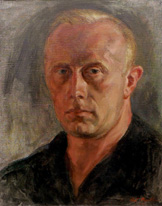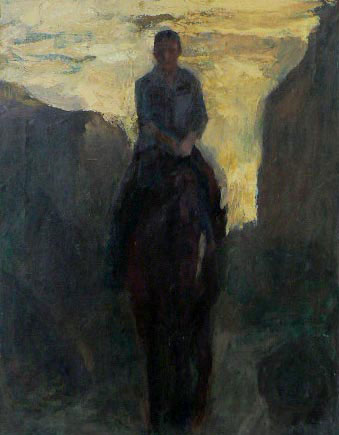|
|
|
Oregon Artist Paul Grellert
By Mark Humpal
|
| .....Joachim Paul Grellert was born
in 1916 in Breslau, Germany during World War I, the son of a talented
self-taught artist named Richard Grellert. In the depressed economy
following Germany's defeat, the Grellert family decided to immigrate
to the United States and with the help of Richard Grellert's uncle
as their sponsor the Grellert family arrived at Ellis Island on October
3, 1926, travelling to Portland, Oregon to settle that year. |
| .....10 year old Joachim entered primary
school in the Woodstock district in Portland, having changed his first
name to "Paul" to avoid the stigma of having an overtly
German first name in post World War I America at a time when anti-German
sentiment still lingered. He eventually attended Franklin High School
where his extraordinary artistic talents were recognized by his art
teacher there, Mary Ellen Driscoll. Driscoll was an accomplished artist
who trained professionally at the Art Institute of Chicago, the University
of Oregon and Reed College, where she received a masterŐs degree in
fine art. Realizing that Paul was preparing to drop out of High School
to help support his financially struggling family, she arranged a
meeting with Mrs. H.C. Wortman, whose husband was a principal of the
Olds, Wortman and King Department store in Portland. Mrs. Wortman
had a long history of involvement in the Portland arts community,
having assembled a formidable collection over the years. She was also
a friend of C.E.S. Wood, purchasing art for her collection from Cottier
and Co. in New York through him. Mrs. Wortman agreed to sponsor Paul
with a 4 year art scholarship which commenced in 1930 with his enrollment
in the Museum Art School in Portland at age 14. He excelled in classes
there under the tutelage of artists Harry Wentz, William Givler, and
others and won 2 Carey prizes during his time there. Along with fellow
students Fred Farr, Maxine Seelbinder, and John Sullivan, Grellert
left Portland to further his art studies at the American Artists School
in New York in the mid 1930s, studying with prominent WPA era expressionist
mural painters such as Anton Refregier and Philip Evergood. |
 Self Portrait by Paul Grellert
Self Portrait by Paul Grellert |

Rider at Dusk
|
| .....The entrance of the United
States into World War II was a traumatic event for the entire
Grellert family in Portland. Paul, who had attained United States
citizenship, was drafted into the Armed Services in late 1941
and entered the Army Medical Corps, eventually being stationed
in various South Pacific locations after training. Paul's parents,
both now classified "Enemy Alien" by the government,
were detained, separated and interned out of state, his father
being sent to Bismarck, North Dakota and his mother to Seagoville,
Texas. Paul's brother Ernie, still a minor, was also classified
Enemy Alien, but was allowed to stay in Portland under restriction
and curfew while he finished High School and completed his citizenship
papers. Surviving letters that Paul wrote to his family were
stamped "Enemy Alien" and subject to inspection by
government officials. |
| .....Grellert was eventually
stationed in Manila, Phillipines for the duration of the war
where he served as a medic. In 1945, he executed a series of
murals for a Serviceman's club in Manila. These murals were
executed in both watercolor and oil, depicting "scenes
from the lives of peons in Mexico." He subsequently painted
a series of pictures of the areas where he had been stationed
during the war including New Caledonia, Luzon, Bouganville and
Guadalcanal. |
|
| .....Returning home from the war, Grellert
married and with his wife Pat, moved to Olympia, Washington where
he was employed as a sign painter for the Bureau of Parks. According
to Grellert's family, Pat was not very supportive of Paul's artistic
pursuits. Additionally, it appears through accounts of family members
that the war left him suspicious and reclusive. He and Pat divorced
and Grellert became less interested in obtaining consistent gainful
employment, preferring to fish and hunt and occasionally working for
his father's sign painting business, "Reliable Sign." Ironically,
Grellert also did most of the door lettering for the new Union Hall
built in the 1960s although he had never joined the signpainters union
and was techincally a "scab." |
| .....In 1938 Grellert
entered an oil sketch entitled "Post Rider" in a nationwide
competition for a commission to execute a Post Office mural under
the Section of Painting and Sculpture for the United States Treasury
Department. His natural talent in figurative work and portraiture
was well-suited to the type of historically rooted and figuratively
based works which began to adorn the walls of post office buildings
across the country in the 1930s. Having won the commission to paint
the mural for the East Portland branch post office, 22 year old Grellert
set up a make shift studio in his family's garage to paint the mural.
With the help of his younger brother Ernie (who also modelled for
a number of the figures in the mural) Grellert installed the mural
in early January of 1939. The mural was executed in tempera on canvas
and was carefully glued in place. The following year, Paul exhibited
two oil paintings at the first All-Oregon Exhibition. The titles of
these works were: "Beach Scene" and "Paul Bunyan and
the Big Swede," both carrying prices of $75. |
| .....Grellert continued to paint wherever
he went, and did countless quick and amazingly accurate portrait paintings
and sketches. He formally exhibited only once after the war in a juried
exhibit "Artists of Oregon" held at the Portland Art Museum
in 1954. |
|
.....In the late 1960s,
Grellert entered the East Portland Post Office and to his dismay
discovered that his "Post Rider" mural had been unintentionally
destroyed during the renovation of the building at that time. Apparently,
there was an attempt to preserve the mural by covering it in plastic,
but the old glue that held the mural to the wall gave way and the
mural fell off the wall and was damaged. Unfortunately, no attempt
was made to conserve the mural and it was thrown out. Grellert approached
Post Office officials with a proposal to repaint the mural, which
was accepted, and the "new" mural was completed in 1970.
This version of the mural was done in oil and a number of changes
were made, the most notable being the color of the horse from white
to brown. The original WPA era competition sketch for the mural
from 1938 resides at the Smithsonian in Washington, D.C.
|
| .....Later in life, Grellert made
his preferred medium watercolor. Developing a hobby of mushroom
hunting, he painted a large collection of watercolor botanical sketches
of various types of mushrooms. He became enamored with the work
of Andrew Wyeth and incorporated this influence into his work in
both oil and watercolor during the 1960s. As he aged he became increasingly
reclusive and miserly, essentially living like a hermit in his modest
Vanport era house in Southwest Portland. This trend accelerated
further with the death of his second wife Gladys. He also became
increasingly critical of his own work and unfortunately destroyed
most of his early paintings, leaving perhaps no more than 50 extant
works. Some earlier works were destroyed to recycle canvas for current
projects. A number of oil paintings which have survived show evidence
that he continued to rework his paintings continuously over the
years, much like Albert Pinkham Ryder, the reclusive and eccentric
19th century artist whose moody works resemble Grellert's in a number
of respects. Confirmation of this influence came from a book on
Ryder which was eventually discovered among his personal papers.
Paul died in Portland at age 88 in late 2005. In addition to oils
and watercolors, he produced a small number of lithographic prints
and diminutive sculptural works. |
|

